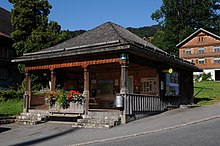Dance house
A dance house is a building for dance events. Dance houses were also used for dance classes and, as large public, centrally located buildings, for other purposes such as holding court.
In historical times there were strict regulations on dancing in many cities and towns . In order to be able to better control these regulations, dancing was often restricted to certain locations. Sometimes separate buildings were built for this or existing dance halls were prescribed as official venues.
Dance houses were often in local centers, often near a rectory or a church , not least to ensure compliance with the regulations by the public and visibility by the local representatives of the Christian churches. Dancing outside of the dance houses was often forbidden.
In Vienna , for example, dancing was not forbidden, but wearing masks outside the ballroom on the flour pit, which had the function of a dance hall and was later replaced by the redoute halls in the Hofburg , and all masked balls had to take place there.
In Hungarian, the word was taken from the German language and is today the name for a special type of folk dance event with audience dancing, the táncház .
Today the word is used in the German language for events of dance schools or derived from its Hungarian meaning for folk dance or folklore dance events. Venues for professional dance also use the word connection, for example Tanzhaus NRW .
literature
- Jodok Bär : The Vorarlberg House. 3rd part. The Vorarlberger Tanzhaus . In: XXXII. Annual report of the Vorarlberger Museumverein . Bregenz 1893 ( digitized version )
- Anton Dörrer : The old dance houses and play tennis in Tyrol , in: Zeitschrift für Volkskunde , 3rd year 1931, issue 4, pp. 50–56 ( digitized version )
- Monika Fink: dance arbors and dance houses. In: Walter Salmen: Mozart in the dance culture of his time. Innsbruck 1990, ISBN 3-90059-015-X
Individual evidence
- ^ Jodok Bär: Das Vorarlberger Haus, 3rd part: The dance house. In: XXXII. Annual report of the Vorarlberger Museumsverein, 1893, p. 42.
- ↑ Monika Fink: Dance arbors and dance houses. In: Walter Salmen: Mozart in the dance culture of his time. Innsbruck 1990, ISBN 3-90059-015-X , p. 23.
- ^ Reingard Witzmann: The country dealer in Vienna. Vienna 1976, p. 3
